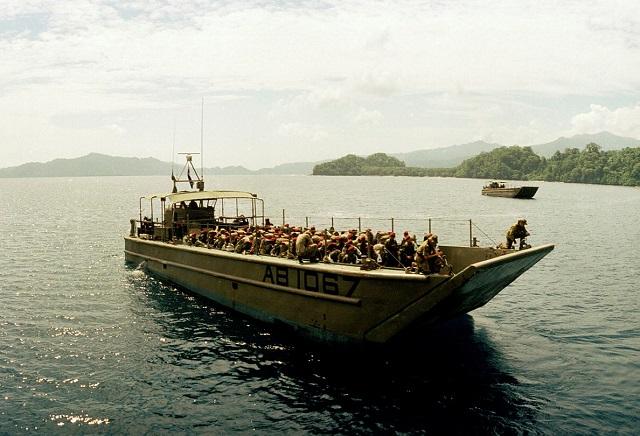Australia’s guarantee to the South Pacific
Posted By Graeme Dobell on March 6, 2017 @ 06:00

Over five decades, Australia has expanded its defence and security guarantee to stretch from Timor-Leste through Papua New Guinea to all of the South Pacific.
Today Australia offers its strategic weight, proximity and resources to be the South Pacific’s ‘principal security partner’. At key moments—in Bougainville, Timor and Solomon Islands—actions have followed words.
The Oz guarantee is a bipartisan consensus with deep roots in history. Coalition and Labor proclaim the peril that’d confront Oz if a hostile power got undue influence in the Islands. A constant strategic denial mindset drives policy map creep.
The first three Defence White Papers in 1976, 1987 and 1994, treated Papua New Guinea as the vital and enduring defence relationship. The rest of the region got a polite assurance of Oz readiness to help.
Public language ramped up in Gareth Evans’ 1989 statement on Regional Security discussing Australia’s ‘disproportionately large’ military power in the South Pacific. That was Gareth’s Brezhnev Doctrine [1] moment, with the statement proclaiming, ‘we would not want, and could not implement, an Antipodean Brezhnev Doctrine for the South Pacific, in which we were the arbiters of political legitimacy or moral acceptability’.
The disavowal of intent, of course, implies the capacity to act, and Gareth set out the ‘unusual and extreme circumstances’ for Australia to use force: unfriendly Island government acting against Oz nationals; direct threat to major interests; finite timeline and clear objective; and ‘if possible the cooperation and participation of other states in the region’.
Then came John Howard’s government which built security guarantees reaching beyond PNG to the rest of Melanesia and East Timor. The 1997 Strategic Policy declared Australia was capable of ‘exerting considerable influence’ in the South Pacific and would maintain its position as the ‘strongest strategic presence in this region’.
Interests in PNG were ‘especially compelling’:Australia ‘would be prepared to commit forces to resist external aggression against PNG’. The PNG promise was relevant to ‘defence relationships and objectives in the Solomon Islands and Vanuatu and, with less force, to other more distant Pacific Island countries.’
Having elevated Solomons and Vanuatu to share a treaty pledge with PNG, the ’97 policy promised ‘substantial support’ to the rest of the South Pacific to deal with external threats, civil disruption or breakdown of law and order. Then came a classic statement of the Oz strategic denial instinct. Australia’s approach to the security of all South Pacific nations ‘recognised that ‘any attack on them – or penetration by a potentially hostile power – would be serious for our security and that, as with PNG, we would very likely provide substantial support in the unlikely event that any of them faced aggression from outside the region’.
The 2000 White Paper repeated the intention to be the region’s key strategic player: ‘Australian interests in a stable and secure Southwest Pacific are matched by significant responsibilities as leader and regional power.’
The 2009 and 2013 white papers toned down the language if not the intent. The 2013 paper boasted of Australia’s ‘central role’ in the South Pacific but cautioned that the ‘growing reach and influence of Asian nations’ introduced new external players: ‘Australia’s contribution to this region may well be balanced in the future by the support and assistance provided by other powers.’
Come the 2016 White Paper, Australia goes in harder and is more detailed about its role as strategic guarantor. It’s a striking note in an important minor key. In Southeast Asia, Australia promises to strengthen engagement and help build regional organisation, but in the South Pacific we will help governments build and strengthen security. The pledge is to ensure government and social stability, not just freedom from military threat.
The paper declares it’s ‘crucial’ that Australia help create national resilience and reduce the chances of instability – a guarantee with much more than a military flavour.
Australia has built military and security muscle: air lift, a couple of quasi aircraft carriers, the next Pacific Patrol Boat [2], and the Army’s growing marine-type qualities.
Since RAMSI [3], the Australia Federal Police has built a considerable Pacific capacity; the military might even call it an expeditionary capability. For the real threats, the AFP can be first responders. And the cops are cheaper.
So that’s what we’ve promised and what we’ve put in place. What could possibly go wrong? Lots.
Australia’s defence role in the Pacific is necessary but not sufficient. The threat of invasion isn’t front of mind for Island governments. The constant problems—governance, population, economy, environment—have military dimensions, but they’re not military problems. Australia’s security pledge can’t be secured merely by military means.
To lead, we must deliver economically and socially. Often we don’t—our leadership lacks followship.
Take the agonising, protracted PACER Plus [4] free trade negotiations. Australia isn’t offering Pacific people anything. For Australia to act on its security guarantee, it is going to need inclusive economic and social policies as ambitious as our security guarantees.
Article printed from The Strategist: https://aspistrategist.ru
URL to article: /australias-guarantee-south-pacific/
URLs in this post:
[1] Brezhnev Doctrine: https://en.wikipedia.org/wiki/Brezhnev_Doctrine
[2] Pacific Patrol Boat: http://www.austal.com/news/austal-awarded-pacific-patrol-boat-contract
[3] RAMSI: http://www.ramsi.org/
[4] agonising, protracted PACER Plus: /rethinking-australias-economic-role-in-the-pacific/
Click here to print.